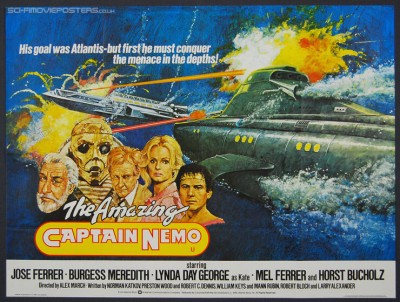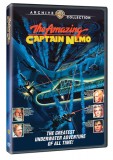| Reviews & Columns |
|
Reviews DVD TV on DVD Blu-ray 4K UHD International DVDs In Theaters Reviews by Studio Video Games Features Collector Series DVDs Easter Egg Database Interviews DVD Talk Radio Feature Articles Columns Anime Talk DVD Savant Horror DVDs The M.O.D. Squad Art House HD Talk Silent DVD
|
DVD Talk Forum |
|
|
| Resources |
|
DVD Price Search Customer Service #'s RCE Info Links |
|
Columns
|
|
|
Amazing Captain Nemo (The Return of Captain Nemo), The
Considering producer Irwin Allen eagerly attached his moniker to some of the worst movies ever made, including The Swarm (1978), Beyond the Poseidon Adventure (1979), and When Time Ran Out... (1980), that he would actually have his name removed from the credits of The Amazing Captain Nemo (1978) is a pretty good indicator of just how bad this mind-blowing atrocity is.
It was made for TV as The Return of Captain Nemo and originally shown in the United States as three 50-minute episodes, but released theatrically overseas in a 102-minute widescreen version, which is what this is. Sadly, it doesn't fall in the so-bad-it's-good category and thus is for Irwin Allen masochists only. I remember tuning out after the first half-hour or so back in '78 and, as alarmingly terrible as it is, I'm grateful to the Warner Bros. Archive Collection for the chance to see the whole awful shebang, and in a nice transfer to boot.
The film opens with naked exposition: mad genius Professor Waldo Cunningham (Burgess Meredith), who dresses like a high school algebra teacher, puts in a video conference call to the U.S. President from aboard his high-tech submarine. (The Raven is manned by androids, played by extras in diving suits spray-painted gold. These may very well be hand-me-downs from Lost in Space.) Threatening to destroy Washington with a "new-klee-ahhhr" missile, as he puts it, Cunningham demands a billion dollars in gold bullion delivered in one week's time.
Meanwhile, Navy Intelligence agents Tom Franklin (Tom Hallick) and Jim Porter (Burr DeBenning) are diving as part of routine war games when they stumble upon the Nautilus, the fabled 19th century submarine of Jules Verne's famed novel. Moreover, inside they find Captain Nemo himself (José Ferrer), perfectly preserved in a state of suspended animation. (Too) quickly emerging alive, well, and completely unfazed by the realization that he's been asleep for 100 years, Nemo immediately agrees to Tom and Jim's suggestion they head for San Francisco to give the sub a refitting. There intelligence officer Miller (Warren Stevens), leader of "an elite Naval group," talks Nemo and the boys into tracking down Cunningham before he can launch that nucleeahhhr missle of his.
Later on, and obviously intended as stand-alone, separate episodes of a proposed series, a radioactive waste disposal expert (Mel Ferrer, no relation to José) and his assistant (Lynda Day George) come aboard, and later still Nemo stumbles upon the lost continent of Atlantis where he meets Atlantian King Tibor (Horst Buchholz), who boasts of a modernized Atlantis built beneath the ruins of the old kingdom. However, all viewers get to see of this is a few middle-aged actors in togas and two generic, peplum-esque sets.
Incredibly, it took seven writers to come up with this dismal film, including horror specialist Robert Bloch. The other six writers were prolific TV journeymen, though oddly most were associated with Quinn Martin- or Jack Webb-produced shows like Barnaby Jones and Dragnet rather than Allen's '60s series for 20th Century-Fox.
When it came to sci-fi television, Allen had a knack for selling shows by blowing his budgets on the pilot films, cramming them with impressive production values and movie-quality special effects. Though all of Allen's '60s shows were dreadful by the end of their runs, contrastingly their pilots were universally impressive from a production standpoint, packing a lot of excitement into an hour show.
But when it came to evaluating scripts Allen was the absolute pits. He couldn't tell a good script from a bad one, and either didn't care or didn't think to hire a story editor that did. Everything he touched was sloppily written, even amateurish. Common to all of his films and TV shows are scripts with paper-thin characterizations, broad stereotypes, bad science, unmotivated action, naked exposition, torturously weak second- and third acts, and on and on.
As is the case even in Allen's best work (e.g., The Poseidon Adventure), the dialogue is extraordinarily clumsy and riddled with clichés. One such exchange occurs when Captain Nemo announces his intentions to swim over and board the Raven:
Tom (or is it Jim?): "You'd be signing your own death warrant!"
Jim (or is it Tom?): "We can't just stand by and watch you commit suicide!"
Captain Nemo: "I'm a sea captain and not a member of a debating society. I'm going aboard and there's no way you can stop me!"
Tom (or is it Jim?): [giving in] "Captain, you'll need someone to hold your coat."
Captain Nemo: "A diving suit has no coat!"
The entire show is filled with sub-comic book level talk like this. When it's not stupid it's bizarrely inapt. Watching the distinguished High Council of Atlantis debate the fate of their ancient world, Nemo interrupts them with, "Enough of this barnyard cackling!" What does he think they are, chickens?
Sporting a shock of white hair and a bushy beard, Ferrer's Nemo looks and acts nothing like Prince Armitage Ranjit Dakkar, the Nemo of Jules Verne's novels. Appropriately aloof but little else, he makes almost no impression. Hallick and DeBenning's roles are blandly conceived and utterly interchangeable; nothing at all distinguishes them.
Beyond his odd pronunciation of the word "nuclear," Meredith walks through the role of Waldo, relying on an annoying actorly trick of constantly putting on and taking off his spectacles (and in-between chewing on their temples). Either the script or Meredith also greatly overuses the word "Sir." In one scene he says it about 30 times. Bored viewers are encouraged to make a drinking game out of this.
Saxophone player Med Flory (leader of the group Super Sax) plays Tor, Cunningham's towering lieutenant. Tall, husky-voiced and with his face hidden behind a bulky gold mask, Tor seems to have been Irwin Allen's idea of a Darth Vader-type villain, but the cartoony mask and costume design backfires miserably. He looks more like Nipsy Russell in The Wiz.
A large part of what affection people have for earlier glories like Voyage to the Bottom of the Sea and Lost in Space is because Allen and/or Fox employed veterans like L.B. Abbott and Howard and Theodore Lydecker to supervise the visual effects and art directors like Robert Kinoshita to design the sets.
But where shows like Voyage to the Bottom of the Sea were extremely handsome by '60s series television standards, the graceless sets and clunky special effects here only accentuate the script's deficiencies and add to the general boredom. The Nautilus is a boxy, cramped affair, and generally unimaginative; there's no logic to the design with neither the 19th century quaintness found in Disney's 20,000 Leagues Under the Sea nor the sheer chutzpah of Allen's Seaview from Voyage. The Raven is even worse, employing as it does a cheat favored by Allen: money-saving partial sets with large, wall-less sections obscured by the blackness of the soundstage.
The miniature effects, which incredibly won an Emmy, are also disappointing. Most of the underwater "money shots" are hard to see because of a peculiar murkiness that resembles vast quantities of fish feces.
Reportedly the model for Nemo's ship was fashioned from a cannibalized Seaview miniature, and there's much obvious cribbing from other Allen shows throughout. Richard LaSalle's score, for instance, incorporates a four-note motif that's almost identical to one heard on Voyage to the Bottom of the Sea. An underwater minefield sequence is composed of stock footage from Allen's 1961 film of Voyage, which he already resued on the subsequent TV show.
The science, as usual for Allen, is dismal. In one scene, Nemo uses an old world map to plot a course for the Nautilus which would take them through southern Argentina and off the surface of the earth entirely. Besides the nucleeahrrr missile, Cunningham's arsenal includes a Z-ray and something called a kro-zare but, dissatisfied, he attempts to steal the "formula" for Nemo's laser.
Video & Audio
Burned onto a DVD-R, The Amazing Captain Nemo is presented in 16:9 enhanced widescreen (at 1.78:1) in this overseas theatrical version which runs 102:16. Despite a few awkward splices and other minor problems it looks just great, as bright and colorful as Fox's DVDs of Allen's Voyage to the Bottom of the Sea. The mono sound is adequate. There are no additional language or subtitle options, and the disc is not closed-captioned. The only Extra Feature is a theatrical trailer, in 4:3 fullscreen.
Parting Thoughts
Though absolutely dire, forgiving sci-fi fans and Irwin Allen apologists will want to have this anyway. But be warned: It lacks the naïve charm of the very worst yet highly watchable sci-fi films, and is simply too uncaring and unambitious to be of much interest. Rent it.
Stuart Galbraith IV's latest audio commentary, for AnimEigo's Musashi Miyamoto DVD boxed set, is on sale now.
|
| Popular Reviews |
| Sponsored Links |
|
|
| Sponsored Links |
|
|
| Release List | Reviews | Shop | Newsletter | Forum | DVD Giveaways | Blu-Ray | Advertise |
|
Copyright 2024 DVDTalk.com All Rights Reserved. Legal Info, Privacy Policy, Terms of Use,
Manage Preferences,
Your Privacy Choices | |||||||















